Slideshow style videos can be a powerful way to bring together the best of your school experiences and share with others.
In the coming months, millions of school and college students will be graduating, and many graduation ceremonies might take place virtually. A slideshow video can play a central role in these online events, providing a meaningful keepsake for graduates.
There are many other occasions where special days, events, and milestones can be marked with a photo montage video.
There are many tools out there to put together slideshow videos with music. This post summarizes 7 free online tools and apps. We also look at the legalities of music and copyright. Finally, you’ll find out how to share your completed video with others or embed it on your blog.
The tools and apps we reviewed are:
- Animoto
- Google Photos
- Quik
- Clips
- iMovie
- Lumen5
- Adobe Spark
Another option that’s currently popular with teachers is WeVideo. This is a fantastic tool but was only free to schools until June 30, 2020. So, it’s a tool you might want to explore depending on your timeline and budget.
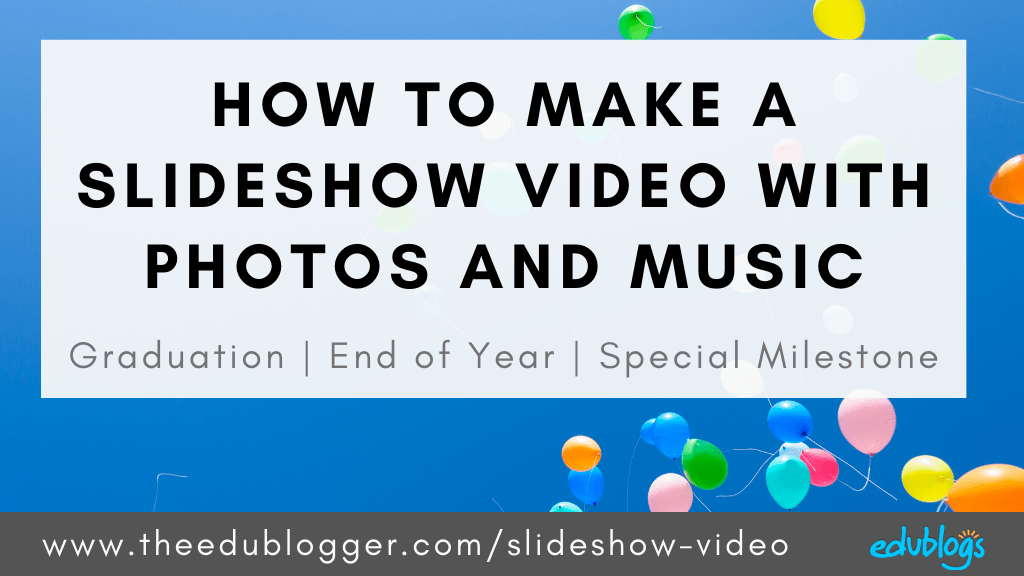
Comparison Chart
Here’s a quick comparison of the 7 tools we review in this post. Read on to find more details and examples.
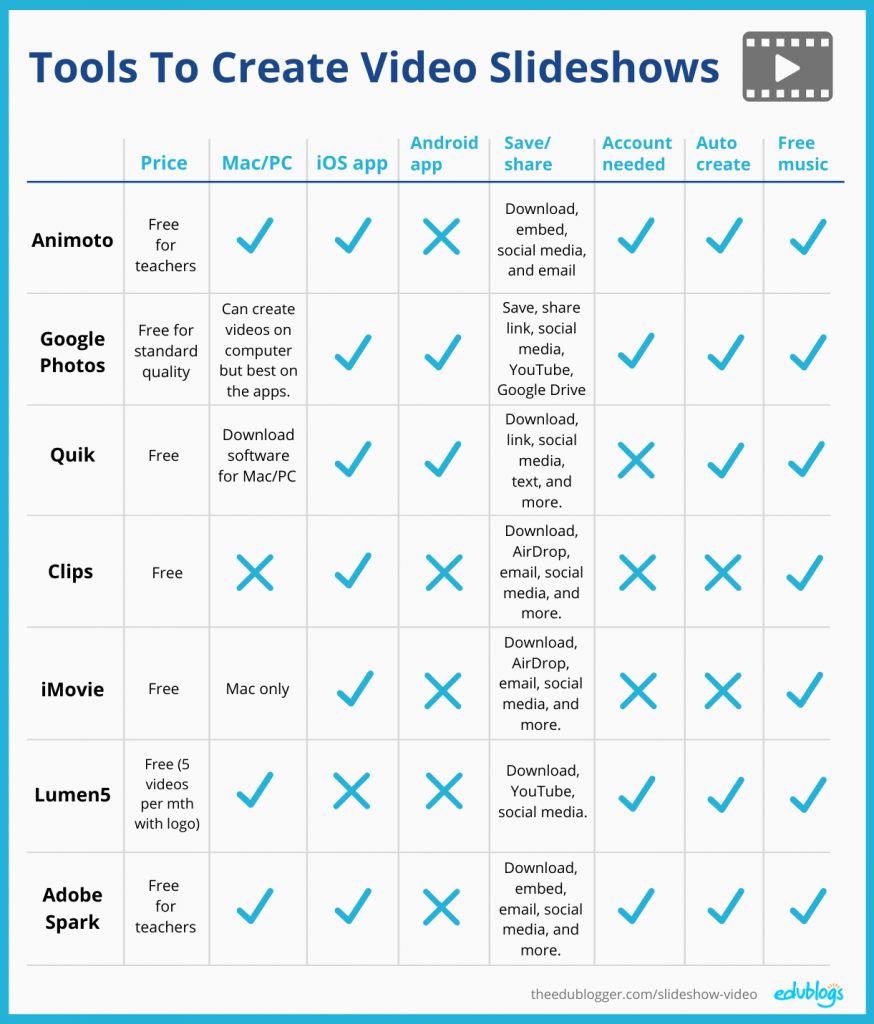
Animoto
URL: https://animoto.com/education/classroom
Use on: The web or iOS app (The Android app has been discontinued)
Animoto allows you to create videos from photos, video clips, and music. There are a number of pre-made video templates available that are designed to make the creation process quick and easy.
Animoto is an intuitive tool that allows you to create a professional-looking video in minutes.
Educators can sign up for a free account which allows you to create student accounts as well.
You can embed Animoto videos on your blog. This help guide shows you where to find the embed code.
Here’s some graduation inspiration from Animoto. Do you have a current example we can use? Let us know in a comment!
Google Photos Movies
URL: https://photos.google.com
Use on: Best on the Google Photos app (iOS | Android)
Do you use Google Photos? It’s a free service to store, organize, and share all your photos and videos. If you’d like to learn more about this service that many of our team enjoy using, check out our beginner’s guide.
You might not know that you can easily make a slideshow of your photos with music using Google Photos.
This is best done on a phone or tablet. You can do it on a computer but the computer version only allows you to create a movie from one of the pre-set themes shown below. This is unlikely to be what you’re after.
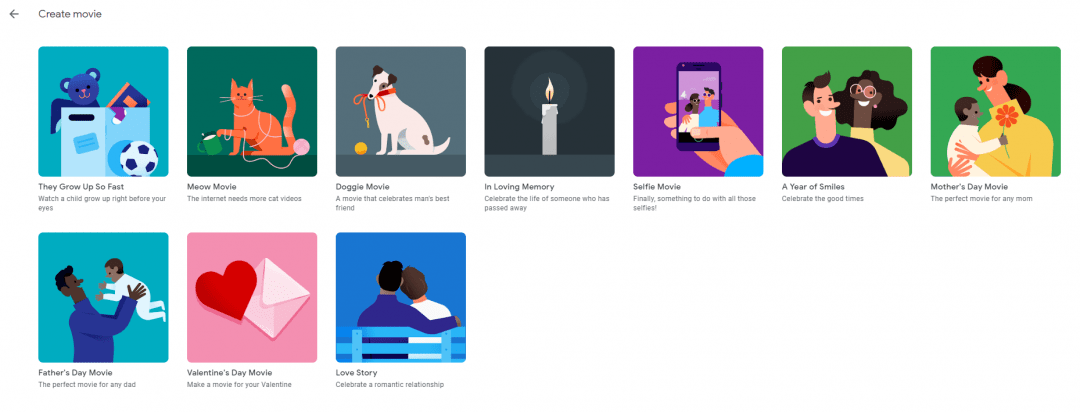
To make a movie on your Google Photos app on your phone or tablet, tap Library and then Utilities.
From here, you’ll select “Movie” and then “Create movie”.
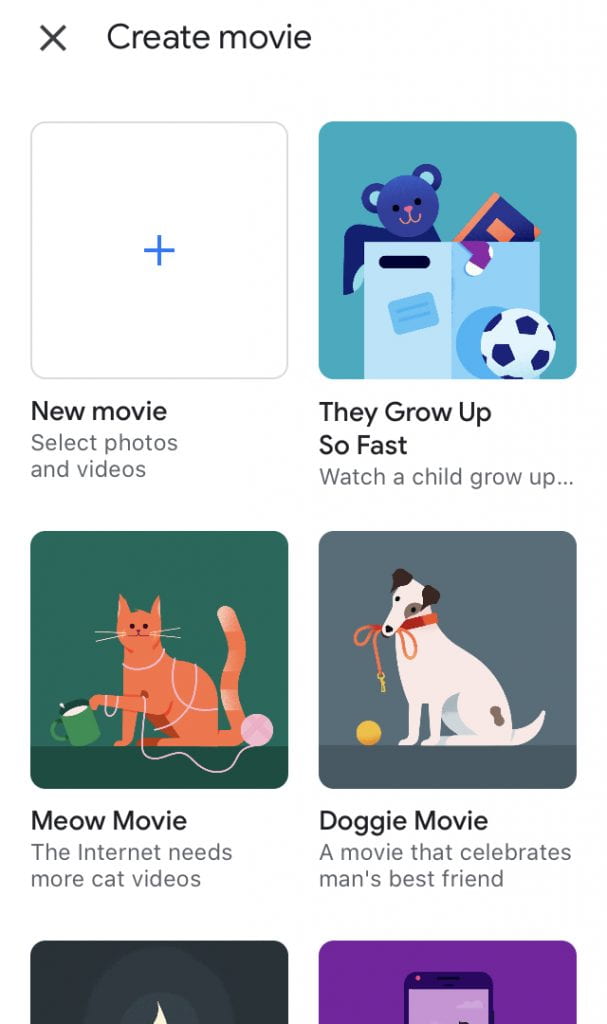
You’ll be prompted to choose your photos or video clips (up to 50). You can then customize your creation by choosing your music and a variety of filters.
When you’re done, there are lots of sharing options. You can share your completed video with friends, save it to your device, publish it on social media, add it to your Google Drive, or share it to a service like YouTube.
Check out these instructions from Google for step-by-step directions.
Quik
URL: iOS app | Android app
Use on: Phone or tablet
Note: There is also a desktop app but it requires downloading software.
If you like creating on your phone or tablet, check out Quik by GoPro. It’s a free app with no in-app purchases.
The Quik app allows you to make video slideshows with professional transitions and music with minimal effort.
You simply select your photos or videos from your camera roll (up to 200). The app then analyses your footage to make smooth and effective transitions. You can choose from 26 themes and customize the video with 100+ music options. You can add your own music but beware of copyright. You can also add text and titles as needed.
Completed videos can be saved to your device or there are other sharing options like social media or text message.
Here’s a short tutorial video by Richard Byrne of Free Technology For Teachers.
Clips
URL: iOS app only
Use on: iPhone or iPad
If you’re looking for a simple video creation tool to use on your iPhone or iPad, Clips might be the answer.
It’s a very intuitive app that lets you create videos out of photos and video footage. There are lots of additional features like text, stickers, emojis, and filters. Because this app is easy to use and has lots of fun features, it’s always a popular choice for students as well as teachers.
Clips now offers a few options for background music; you can create your own music in GarageBand as well as using their built-in soundtracks. Additionally, you can pull in music from your iTunes account but please be cautious of copyright.
One unique feature of Clips is Live Titles which is a built-in caption feature. Users can choose to have their words appear as they speak. The words can come up all at once as static text, or as animated text with each word highlighted as they’re spoken.
Here’s an example of a short video created in Clips by teacher-librarian Jo Martin from Brandon Elementary. It’s called LEGOmania in the Library.
iMovie
URL: iOS app | macOS
Use on: iPhone, iPad, or Mac computer
iMovie is a step-up from Clips with a lot more features that allow you to create anything from a short video slideshow to an impressive full-length movie.
Unlike a lot of the tools reviewed in this post, iMovie doesn’t do the work for you. There are handy templates to enjoy but you need to add your own photos, videos, titles, and music to put your video slideshow together.
Some of the special effects available include the ability to slow down or speed up footage, as well as picture-in-picture and greenscreen effects. While these are awesome, they may be more than you need to create a simple photo montage.
If you don’t have your own music to add to the video, iMovie offers 80+ soundtracks and there is also the option to add your own voice-over narration.
Here’s an example from teacher-librarian Amy Kincaid. She used iMovie to create a video that condensed her year with Jackson Elementary students into 7 minutes.
Lumen5
URL: https://lumen5.com
Use on: Computer (or on a phone/tablet via the web browser)
Lumen5 is a free drag and drop video creator. It’s most known for its ability to turn blog posts into videos, however, it can also be a handy tool for creating video slideshows using images, short clips, GIFs, and music.
When you log in to Lumen5 and opt to “Create a Video”, you’ll be given three choices as outlined below. You can “automagically” make a video from your blog post, script, or media.
To make a slideshow style video with music, select “Use your media”.
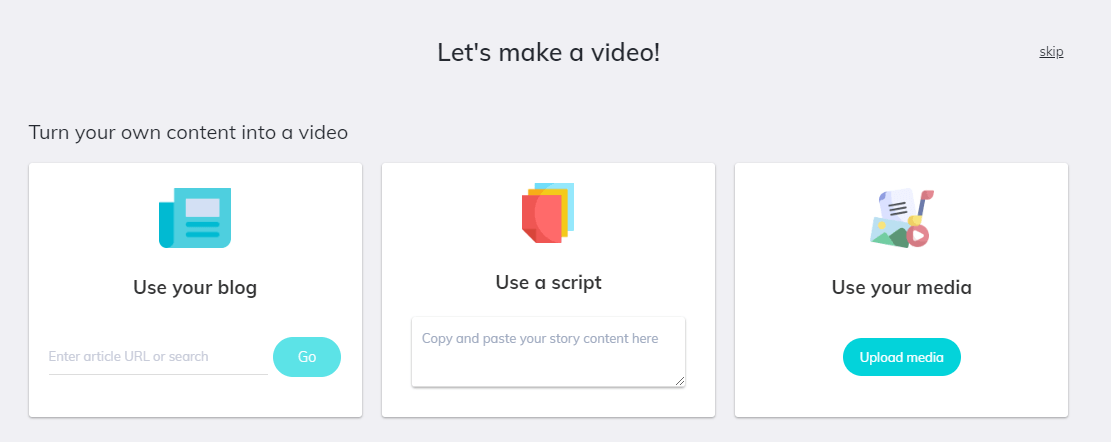
Lumen5 contains a library of Creative Commons Zero images and music if you need some content to complement your own collection.
This is a fabulous tool with some minor downsides being:
- The free plan allows you to make 5 videos a month in 720p resolution
- The free plan has a Lumen5 watermark
- It’s 13+ (so if you have younger students, they can’t create their own videos)
- You can’t embed your video directly onto your blog. So you have to put it on social media or YouTube first and then get the embed code from there. Or you could download the video and upload it directly into your post/page if it’s a small file. Scroll down for more details on embedding.
In this video, Richard Byrne from Free Technology For Teachers shows how to create a Lumen5 video from a blog post. You can modify the instructions and select “Use your media” if you don’t want to base your video on a blog post.
Adobe Express (Formerly Spark Video)
URL: https://www.adobe.com/express/create/video
Use on: The web or iOS app
If you’re an educator who is going to be using Adobe Spark, you might want to first make sure you’ve signed up for an education account. This will give you free premium features.
Adobe Spark Video allows you to combine pictures, videos clips, icons, text, voice, and music to create compelling videos.
If you need extra footage or a soundtrack, there is a free database of images and music.
If you’d like to read a “how-to” on creating an end of year celebration video, check out this detailed explanation from Monica Burns.
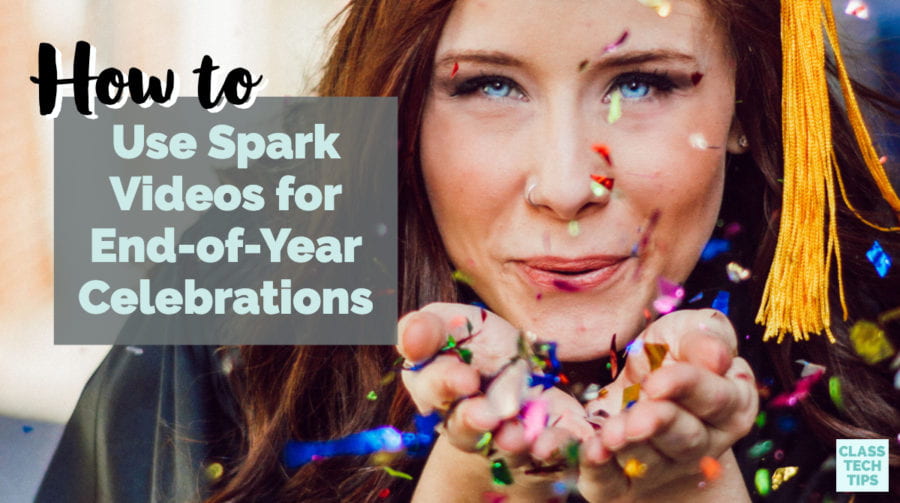
Here’s an example of a video made in Adobe Spark by teacher Laura Hanser Burkhalter. She used photos that were emailed to her from members of her school community.
Music and Copyright
When you’re creating a slideshow style video it can be extremely tempting to use popular music that reflects the mood and emotion of the footage.
As you probably know, most music is protected by copyright. It doesn’t matter if you paid for a song or not, it’s still protected by copyright. It doesn’t matter if you’re only using 30 seconds or less of a song, it’s still protected by copyright.
Normally, you can’t just use any music you like in your video creations.
However, in many countries, you are allowed to copy music to add to a video if:
a) it’s for educational purposes and
b) you’re not sharing your video publicly (or selling it!)*
So, if you make a video with music that’s protected by copyright, it’s not okay to publish this on a public blog, social media, YouTube, and so on. And you couldn’t show your video at a public event. However, it’s okay if the video is just being shown privately to teachers, students, and families at home/school.
It’s also important to note that background music is not considered “educational use”.
Despite the flexibility in these rules for educators, it’s always a good idea to not only think about loopholes but consider ethics and how to be the best digital citizen you can be. As everyone can now be a publisher, copyright is an important topic for educators and students to have a grasp on.
*Note: This is the case in Australia and the US but if you live in another country you may need to check your own guidelines.
Here’s a brief summary of the above. You’re welcome to share this graphic on your own site, LMS, or social media with attribution.
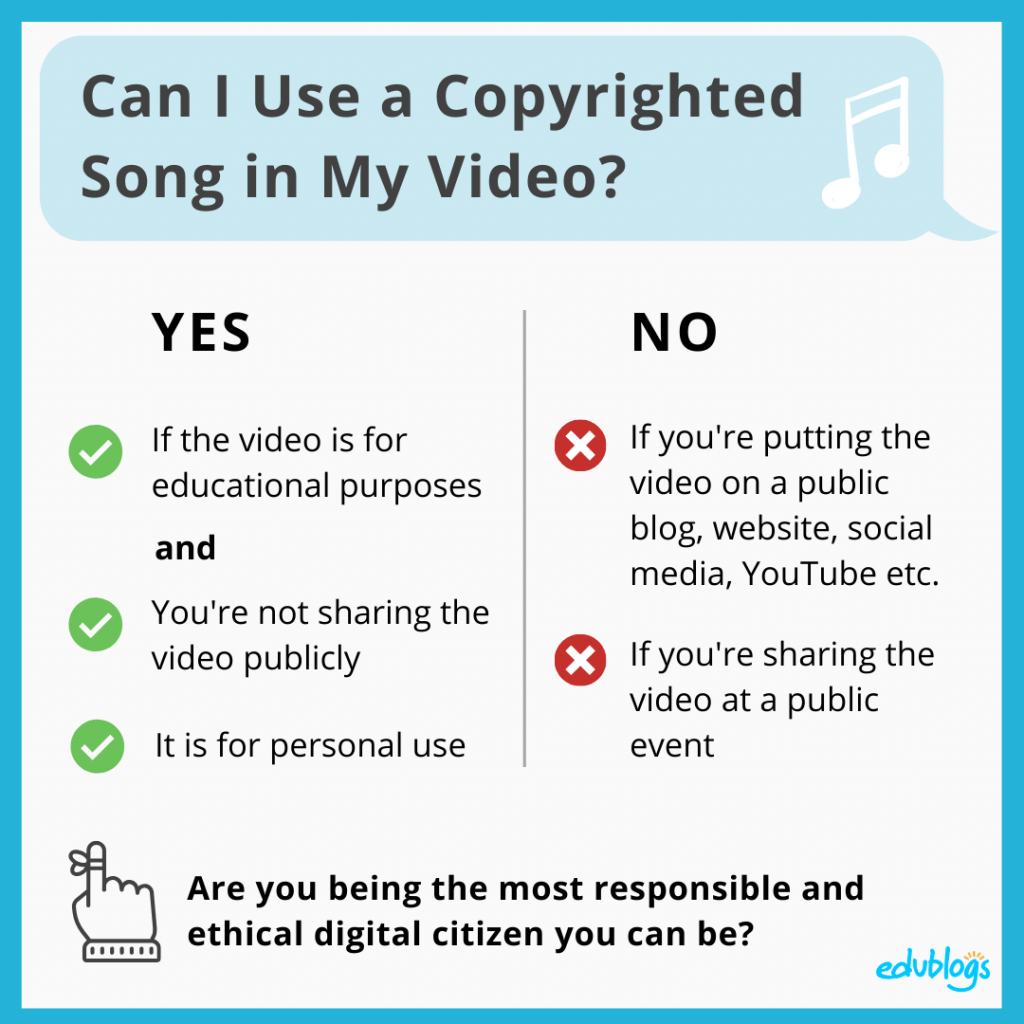
Copyright Free Music
Luckily, many of the free online tools and apps available now have inbuilt music options that are free to use. All the tools and apps we’ve reviewed in this post have some free music options.
However, if you’re looking for some other copyright free music options, you might first like to check if you district has any subscriptions you can make the most of. For example, Soundzabound.
If this isn’t an option, there are lots of other sources of free music online like YouTube Audio Library.
Let’s take a look.
YouTube Audio Library
YouTube has a great library of music you can use. In case you’re wondering, using an online tool to download music from a YouTube video is not okay.
Visit the Audio Library section in your YouTube Studio to browse the selections.
You can filter your results to find music that doesn’t need to be attributed.
You can preview the music to hear what it sounds like and download the music you want to use.
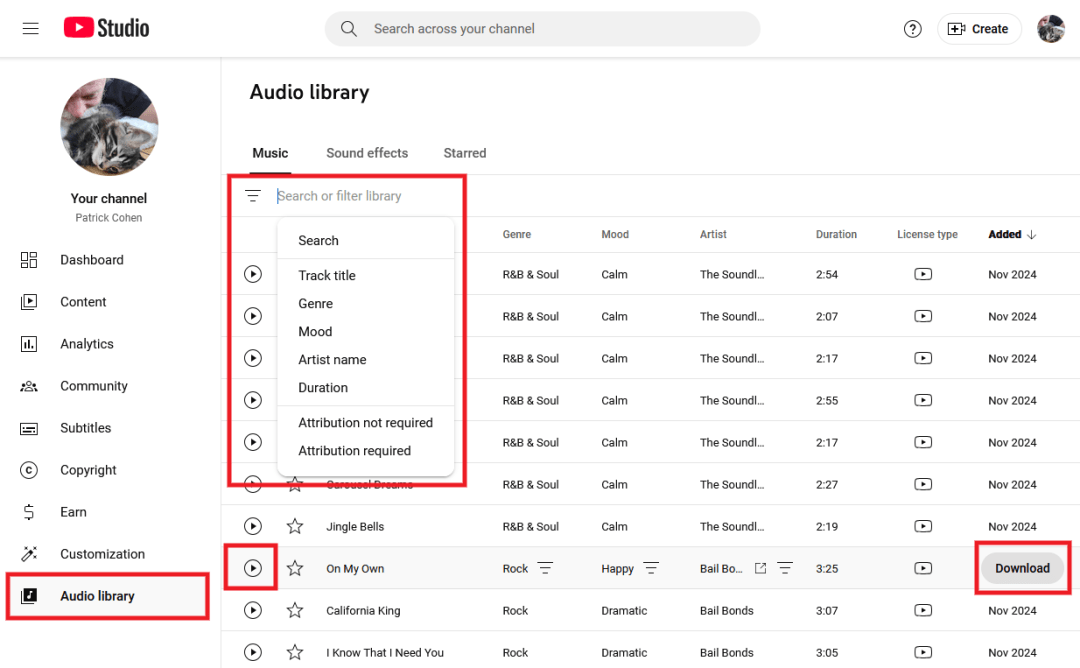
Here’s an example called Sunshine in my Heart by Jingle Punks.
There are many other ways you can find copyright free music online so please let us know if you have a favorite.
How To Add A Video To Your Blog
Videos can be quick and easy to make but sharing them can be more difficult due to large file sizes.
If you want to share your video on your blog or website, first check whether the tool you’re using offers an embed code. If you’re using an online tool like Animoto or Adobe Spark Video you’ll be able to use an embed code to add the video to your blog quickly and easily. You can find the full instructions on how to embed videos in this Help Guide.
If you’re not using an online video tool that offers an embed code, you’ll want to download the video to your device. From there you’ll upload your video to a third party service and then embed it. Most videos are too large to upload directly to your blog or site.
These are third party services you might consider to house your videos:
- An online hosting site (e.g. YouTube, Vimeo, TeacherTube)
- Google Drive
- A Cloud service like DropBox or OneDrive
- Social media (many services have limits on video length e.g. Instagram 60 seconds, Twitter 2 minutes 20 seconds, LinkedIn 10 minutes, Facebook 120 minutes)
If you’re uploading your educational videos to a platform like YouTube or social media, check your school/district guidelines for advice and choose your privacy settings carefully.
Once you’ve uploaded to one of these services, you can embed the video on your blog, website, or LMS, or share a link. If you’re embedding a video, you can use the instructions below.
Methods For Embedding Videos
Videos from video sharing websites can be embedded into posts or pages by either using:
- The video URL: Paste the URL on a line by itself in your post/page editor where you want the video to appear. This method only works with certain services, like YouTube.
- The embed code: Find the embed code on the site you’re using (e.g. YouTube) and copy it. Then in your post put your cursor where you want the video. Click on Add Media and then Insert Embed Code. Paste the code and press Insert into post. Note: embedding isn’t available on free blogs to prevent misuse from spammers.
You can find the full instructions on how to embed videos in this Help Guide or check out the PDF below for detailed instructions for YouTube.
Download the PDF of the embedding instructions.
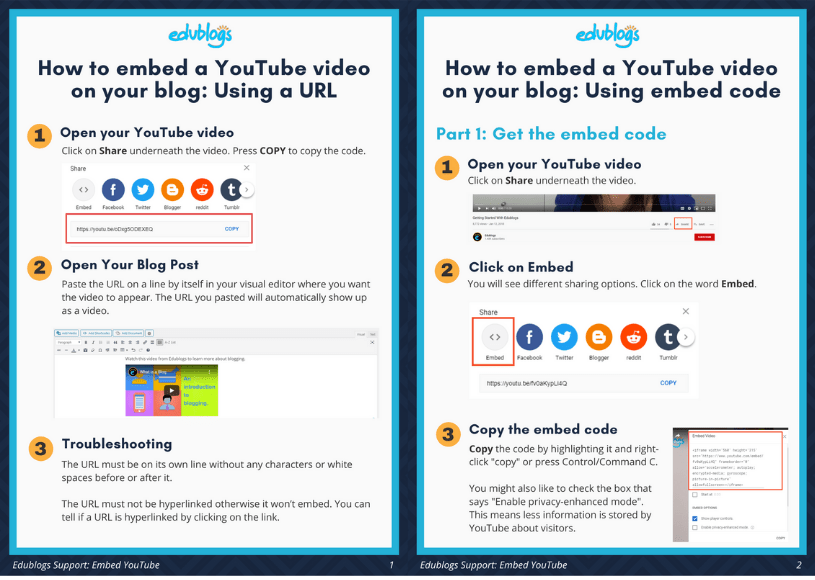
Related Posts
You might also enjoy reading:
The Educator’s Guide To Using Video In Teaching And Learning
How To Deal With Student And Class Blogs At The End Of The Year


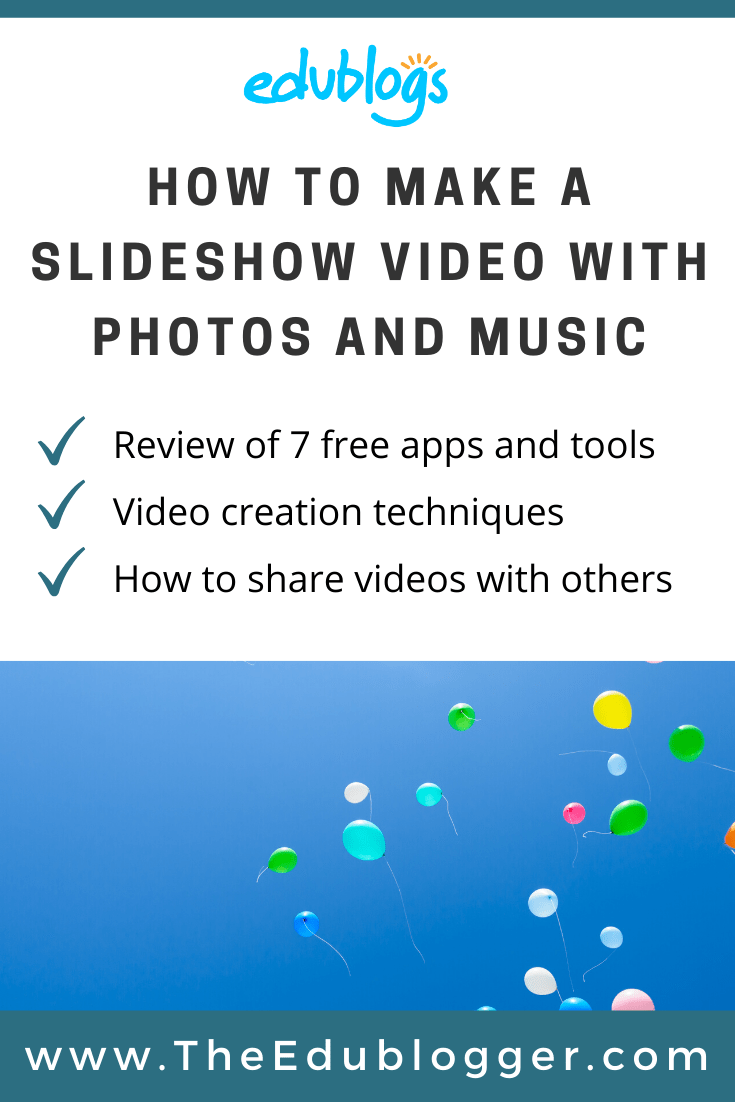
How can you share these “educational” videos with copyrighted music? I was planning on using imovie, but I’m not sure how to share it with families.
Hi Winnie,
If you use copyright music, it will be copyright infringement to share it publicly on a platform like YouTube (and it will probably be removed too).
You could add it to your Google Drive perhaps and share a private link with families? Or if you have a password protected LMS that might be an option too.
Good luck!
Interesting. Thank you
are we able to put slid show on are blogs or can we add a like From a google slideshow
Hi there, you might want to check out our post on Google Slides which shows you exactly how to embed a Google Slides presentation onto your blog. https://www.theedublogger.com/google-slides/
Good luck!